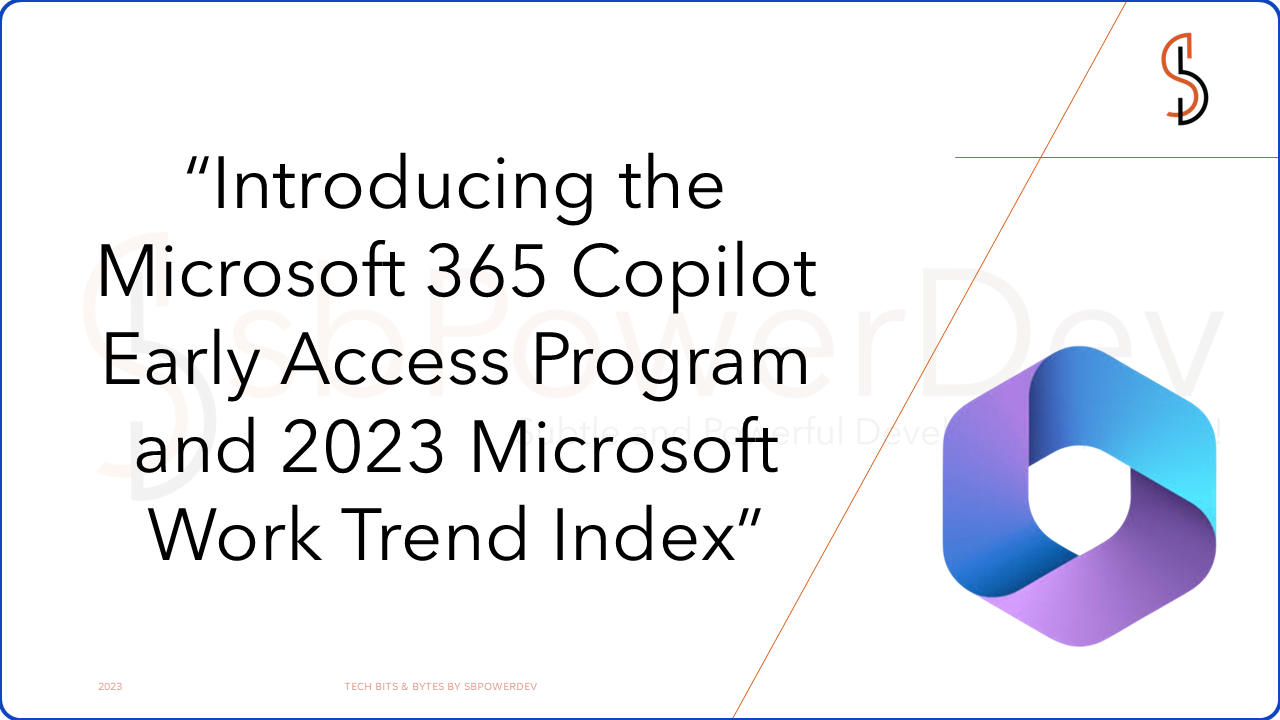
We unveiled Microsoft 365 Copilot, your work copilot, to the public in March. As we deliver Copilot to more users and roll out new features, we’re happy to discuss the next phase of our journey. We’re also publishing fresh information and analysis on the state of work in the AI era from our 2023 Work Trend Index.
Microsoft 365 Copilot Early Access Program
We’ve been beta testing Copilot with 20 business customers since March, learning from organizations including Chevron, Goodyear, General Motors, and Dow. The consensus among them is that Copilot has the ability to transform the workplace. They emphasize how it completely changes meetings and is starting to change the way they produce. They’ve also pointed out places where we might help individuals adjust to this new style of working more effectively, such the requirement for more conversational engagements with many turns. We’ll continue to rely on this kind of user feedback as we expand the client base for Copilot in order to improve the product and support users as they adjust to this new way of working.
The Microsoft 365 Copilot Early Access Program, a premium, invitation-only preview that will be made available to 600 clients initially across the globe.
We’ve been beta testing Copilot with 20 business customers since March, learning from organizations including Chevron, Goodyear, General Motors, and Dow. The consensus among them is that Copilot has the ability to transform the workplace. They emphasize how it completely changes meetings and is starting to change the way they produce. They’ve also pointed out places where we might help individuals adjust to this new style of working more effectively, such the requirement for more conversational engagements with many turns. We’ll continue to rely on this kind of user feedback as we expand the client base for Copilot in order to improve the product and support users as they adjust to this new way of working.
2023 Work Trend Index
AI platform transition is well under progress. The same way that customers looked to Microsoft for assistance in making the transition to flexible and remote work, they are now coming to us for assistance in understanding how this new AI era will change work yet again.
In order to understand what the new AI era of work will entail, our 2023 Annual Work Trend Index polled 31,000 people in 31 countries and examined trillions of aggregated productivity signals in Microsoft 365 in addition to labor market trends on LinkedIn. The data clearly shows that employees are straining under the weight of work, which puts innovation at risk. The pace and volume of labor have increased rapidly. Both managers and staff are eager for AI to reduce the workload.
According to Satya Nadella, chairman and CEO of Microsoft, “This new generation of AI will eliminate the monotony of work and unleash creativity.” The potential for AI-powered products to reduce digital debt, advance AI skills, and empower workers is huge.
Three crucial findings from the study that corporate executives should be aware of as they try to safely adopt AI are as follows:
Digital debt costing us innovation
- The amount of data, emails, and conversations has beyond our capacity to process it all, leaving us all with digital debt. Every minute spent paying off this digital debt is time that could be spent being productive. Digital debt is more than just a hassle; in a world where innovation is the new productivity, it has an effect on company.
- The amount of data, emails, and conversations has beyond our capacity to process it all, leaving us all with digital debt. Every minute spent paying off this digital debt is time that could be spent being productive. Digital debt is more than just a hassle; in a world where innovation is the new productivity, it has an effect on company.
- There is less time for critical thinking, creative expression, and social collaboration when 62% of employees say they spend too much time talking, coordinating, and seeking for information. Almost two out of three people claim they lack the time and energy necessary to complete their tasks. Additionally, there is a 3.5-fold increased likelihood that these same workers have difficulty with innovation and strategic thinking.
There’s a new AI-employee alliance
- One of the most common myths about AI is that workers are afraid they will eventually lose their jobs as a result. A startling 70% of our survey participants said they would seek to assign as much work to AI as possible in order to reduce their workloads, even if 49% of them expressed some concerns about their job security. Simply put: The promise of relief exceeds the threat, and employees are aware of what’s at stake. They envisage deploying AI for both analytical and creative work, in addition to administrative responsibilities.
- Employees and managers can agree on this issue. According to our statistics, managers are twice as likely to say they want to use AI to enhance rather than replace people. In actuality, cutting staff was last on their list. Their highest ambitions for AI? enhancing output, automating processes, improving employee wellbeing, and allowing workers to concentrate on important work.
Every employee needs AI aptitude
- Human-computer interaction will change dramatically as a result of AI, and eventually we won’t be able to envision doing our jobs without it. A platform move this significant will call for new skill sets, ranging from quick engineering to using AI to reimagine procedures. We’re already observing a 79% year-over-year rise in the number of LinkedIn job listings in the U.S. that include “GPT” or “GAI” (generative artificial intelligence). Eighty-two percent of CEOs predict that workers will require new skills in the AI era.
- The majority of workers would prioritize learning new talents if they had more time and energy, so they are prepared for this new aptitude. Leaders concur in this: Learning new skills is also the No. 1 thing they wish their employees would do with more time and energy
Introducing new Microsoft 365 Copilot capabilities
When the Copilot introduced in March, we made available features across the Microsoft 365 family of productivity tools, which millions of people use on a daily basis. We won’t stop there; we’ll keep adding new Copilot features to bring AI to every aspect of the suite, empowering businesses and workers to release creativity, unlock productivity, and advance their skill sets.
- Copilot in Whiteboard will make Microsoft Teams meetings and brainstorms more creative and effective. Using natural language, you can ask Copilot to generate ideas, organize ideas into themes, create designs that bring ideas to life and summarize whiteboard content.
- By integrating DALL-E, OpenAI’s image generator, into PowerPoint, users will be able to ask Copilot to create custom images to support their content.
- In order to help users compose more effective emails and communicate more confidently, Copilot in Outlook will provide coaching ideas and suggestions on clarity, sentiment, and tone.
- Copilot in OneNote will employ prompts to build plans, ideas, lists, and information organization so that users can quickly find what they need.
- Copilot in Loop helps your team stay in sync by quickly summarizing all the content on your Loop page to keep everyone aligned and able to collaborate effectively.
- Copilot in Viva Learning uses a natural language chat interface to assist users in planning upskilling courses, finding pertinent learning resources, and arranging time for required trainings as part of a tailored learning journey.
Our AI guiding principles and Responsible AI Standard, as well as decades of research on AI, grounding and privacy-preserving machine learning, serve as our benchmarks as we introduce Microsoft 365 Copilot to clients. Our AI systems are reviewed by a multidisciplinary team of researchers, engineers, and policy experts for potential risks and mitigations. This includes improving training data, filtering out harmful content, blocking sensitive topics in queries and results, and using Microsoft technologies like InterpretML and Fairlearn to help identify and correct data bias. By highlighting restrictions, including sources, and encouraging people to examine, fact-check, and update information in light of their subject-matter expertise, we make it apparent how the algorithm decides what to do.
An entirely new wave of productivity development is being ushered in by the platform transition to AI. That promise can’t arrive soon enough for both overworked staff and leaders wanting to increase productivity. AI symbolizes a completely different style of working, one that will call for new abilities and routines. Businesses that adopt this new method of operation, moving from AI on “autopilot” to AI as copilot, will make the future of work more promising and satisfying for all employees.















